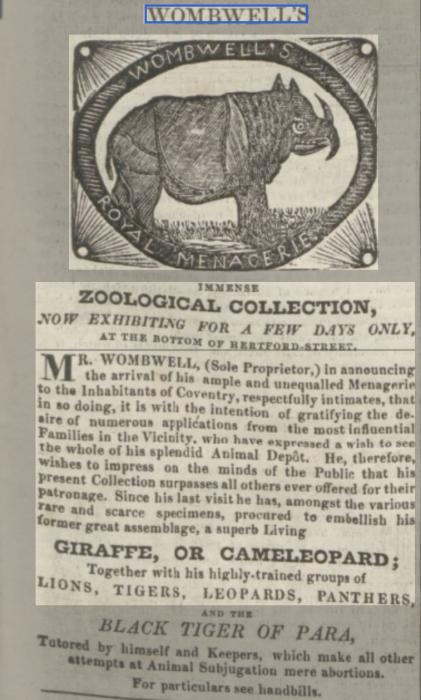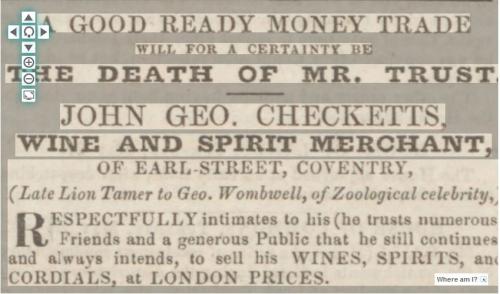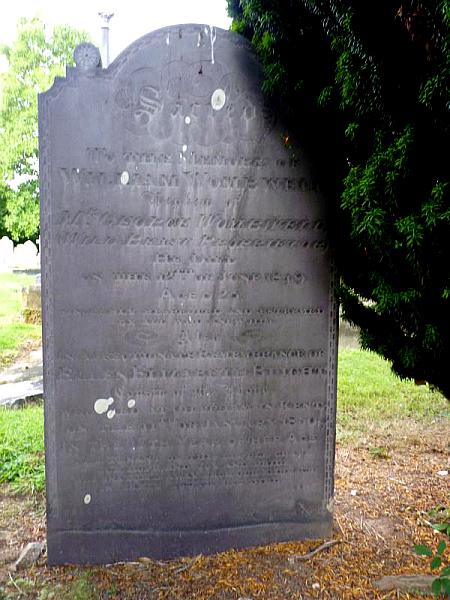
|
Annewiggy
Tamworth |
166 of 241
Tue 25th Jun 2019 11:32am
An advert from 1841

|
| Buildings - Little Palace Yard | |
|
NeilsYard
Coventry |
167 of 241
Tue 25th Jun 2019 11:45am
Fantastic, Anne! I like how he calls it the 'Royal' Menagerie. I had to lookup what a Cameleopard was.
In 46 BC Julius Caesar had celebrated his triumphs in Egypt by returning to Rome with a vast menagerie, the star attraction of which was a giraffe, the first ever seen in Europe. The Romans did not know what to make of such an animal and named it the cameleopard, for it seemed to them to embody characteristics of both the camel and leopard. |
| Buildings - Little Palace Yard | |
|
Helen F
Warrington |
168 of 241
Tue 25th Jun 2019 2:38pm
Great find Anne. I only know of the Cameleopard because it was a question on QI. I'm amused by the thought process that instead of thinking 'this is an animal I've not seen before' they come up with the idea that two known species had nookie. |
| Buildings - Little Palace Yard | |
|
Kaga simpson
Peacehaven, East Sussex |
169 of 241
Tue 25th Jun 2019 2:53pm
The whole thing was what we call today a small zoo, right there in the centre of the city.
Checkitts reared the two lions himself from whelps in Scotland. One he named 'Nero" that was in its prime - a magnificent beast, he could do anything with it, but its brother "Wallace", although smaller, was a more formidable, savage animal.
Now an arbour (trees) as nothing to do with the ground, it's the surround, be it bush, tree or whatever, used by courting couples mainly, and part of nearly every garden in England in the early centuries.
As Wombwells was the largest menagerie in England it would have become royal at some stage.
But Wombwells the band was as much an attraction as the animals.
Let's not forget that Coventry had a bear ring, before it had the cross.
Your photo on 153 was the entrance. The stone animals you are talking off were merely the old way of sign posting. |
| Buildings - Little Palace Yard | |
|
Helen F
Warrington |
170 of 241
Tue 25th Jun 2019 5:12pm
It's not at all implausible that the 'arbour' was a doorway in a larger garden at some point prior to 1850. There do look like doors at the back of the arbour and the thing was set into the wall, not in front of it. The newspaper photo showing it in the relocated spot shows daylight through the arch. The arbour was either medieval salvage from the destruction of the priories (eg a tomb canopy) or carved in the Georgian era to look like medieval. If the former, the animals (give or take the lion) are most likely not contemporary with the arbour. The garden features are follies, not original features dating back to the medieval. The 'arbour' is at the end of the substantial Little Palace Yard garden and backed onto another long plot behind the house with the Knaves Post in Much Park Street.
In the medieval or even Jacobean period there was a distinctive divide between the Much Park Street and Little Park Street garden plots. This line ran north to the Red ditch, which ran from the south edge of the George Inn on LPS to the north edge of the Knaves Post house on MPS. The main properties on Earl Street ran down to the red ditch. At some point prior to 1750 this pattern began to break down as people no longer needed or could afford long gardens. The area just south of the red ditch was cut up and bits of it changed hands, adding to the extent of the Earl Street plots, (hence the long plot for the Palace Yard).
The area east of LPY, beyond the arbour, seems to have been an orchard running east to the house on Much Park Street with the Knaves Post. In 1850 there was a small building blocking the way into that orchard from the arbour, even if the doors opened. The orchard at that time was connected to a house on Earl Street. Since the possession of those plots swapped around it's not impossible that at some point the orchard beyond the arbour belonged to the Little Palace Yard when the Arbour was set in place. |
| Buildings - Little Palace Yard | |
|
Helen F
Warrington |
171 of 241
Tue 25th Jun 2019 10:54pm
Wombwell's elephant was an Indian one.
Etching at the V&A |
| Buildings - Little Palace Yard | |
|
Gilly
Melbourne Australia |
172 of 241
Wed 26th Jun 2019 6:39am
You guys are just amazing. All so interesting. Gilly |
| Buildings - Little Palace Yard | |
|
Kaga simpson
Peacehaven, East Sussex |
173 of 241
Wed 26th Jun 2019 7:43am
Helen F
Could well be, but Checketts was different to Wombwells - he owned some of the animals he trained for Wombwell and the two cubs were born in Scotland, so hey, they're Scottish lions!
From 'Nero' to Checkettes on day of opening:
"You nursed me when I was a whelp, and didn't know good breeding
You taught me genteel manners, attended to my feeding
Though I was born of savage race,vof parents famed for beauty
How tenderly you brought me up, and made me know my duty
I'm very glad, you're doing well, for well I know your merits
And it pleases poor 'Nero' that you are a man of spirits".
At that time Jerry Wombwell, deceased. |
| Buildings - Little Palace Yard | |
|
Annewiggy
Tamworth |
174 of 241
Wed 26th Jun 2019 11:43am
Just a little to add to Kaga's information about John George Checketts. He took over the The Marble Hall, Wine and Spirits merchants in Earl Street in 1851. Sadly he died in October the following year aged 43. This confusing advert was placed in the Coventry paper after his death!
 A newspaper article about the death of Ellen Blight, the Lion Queen who was killed by a lion in 1850, says that the body was placed under the care of Mr George Checketts of Cow Lane & taken to the cemetery & deposited with the mangled remains of her cousin Mr William Wombwell (they pulled no punches then!) who was killed by an elephant at Coventry show fair in June 1849. Was this what decided Mr Checketts to give up lions and go into wines and spirits (and perhaps spirits of the other world as well?
A newspaper article about the death of Ellen Blight, the Lion Queen who was killed by a lion in 1850, says that the body was placed under the care of Mr George Checketts of Cow Lane & taken to the cemetery & deposited with the mangled remains of her cousin Mr William Wombwell (they pulled no punches then!) who was killed by an elephant at Coventry show fair in June 1849. Was this what decided Mr Checketts to give up lions and go into wines and spirits (and perhaps spirits of the other world as well? |
| Buildings - Little Palace Yard | |
|
NeilsYard
Coventry |
175 of 241
Wed 26th Jun 2019 12:00pm
As per earlier, and thanks to Derek, this is the grave, Anne. I don't think there are any carvings on it as such.
 Sacred to the memory of William Wombwell nephew of Mr. George Wombwell (wild beast proprietor) he died on the 12 Jun 1849 aged 25. Sincerely respected and esteemed by all who knew him.
Also in affectionate remembrance of Ellen Elizabeth Blight (cousin of the above) who died at Chatham in Kent on the 11 Jan 1850 in the 17th year of her age.
The tenant of this little grave, our hope, and joy, and pride, was snatched away from our embrace in early youth she died.
Sacred to the memory of William Wombwell nephew of Mr. George Wombwell (wild beast proprietor) he died on the 12 Jun 1849 aged 25. Sincerely respected and esteemed by all who knew him.
Also in affectionate remembrance of Ellen Elizabeth Blight (cousin of the above) who died at Chatham in Kent on the 11 Jan 1850 in the 17th year of her age.
The tenant of this little grave, our hope, and joy, and pride, was snatched away from our embrace in early youth she died.
|
| Buildings - Little Palace Yard | |
|
Helen F
Warrington |
176 of 241
Wed 26th Jun 2019 12:19pm
I think that the garden features date from when it was renovated from a medieval house. I doubt that a lion tamer or even a wine merchant would have been able to afford to do it. By 1850 the site was divided up into tenements and while I could be wrong, I think the renovations suggest one grand owner, not a mixture of owners and renters. So 17s, not early 18s. Maybe even the late 16s as that style started before the Georgians. If the arbour was a gateway to the orchard, that also indicates an early date because in some of the deeds I've been looking at, the orchard was occupied by a blacksmith Mr Thomas Trickett in the early 1800s.
I've a feeling I've read somewhere who renovated it but the LPY got mixed up with the Palace Yard on several occasions, especially in my mind. |
| Buildings - Little Palace Yard | |
|
Annewiggy
Tamworth |
177 of 241
Wed 26th Jun 2019 12:29pm
Thank's both for your quick responses. It is all very interesting, a difficult area to unravel!
|
| Buildings - Little Palace Yard | |
|
Helen F
Warrington |
178 of 241
Wed 26th Jun 2019 2:23pm
Checking my own notes - about the garden features I've got a date of 1701.
From the library pictures - Porch in Little Palace Yard, dated 1701, Coventry. Moved to Memorial Park. It even calls it a porch, which ties in with it being a route into the orchard. I've noted that the animals are later additions.
Another comment about the tiger - Little Park Street, carved stone wall pediment, William 3rd mansion (Little Palace Yard). So the renovations of the property would have been for William III (who lived 1650-1702). No shortage of money to buy up surrounding plots. |
| Buildings - Little Palace Yard | |
|
Helen F
Warrington |
179 of 241
Wed 26th Jun 2019 2:54pm
Looking at the William III features on the inner courtyard and the front - the curved wall features were probably the top of the wall (not set within) and decorated with balls. So like the image with the elephant but with just a stone sphere.
 |
| Buildings - Little Palace Yard | |
|
Helen F
Warrington |
180 of 241
Wed 26th Jun 2019 3:07pm
Here's William III. Imagine him striding about the place.
|
| Buildings - Little Palace Yard | |
This is your first visit to my website today, thank you!
4,126,633Website & counter by Rob Orland © 2024
Load time: 596ms